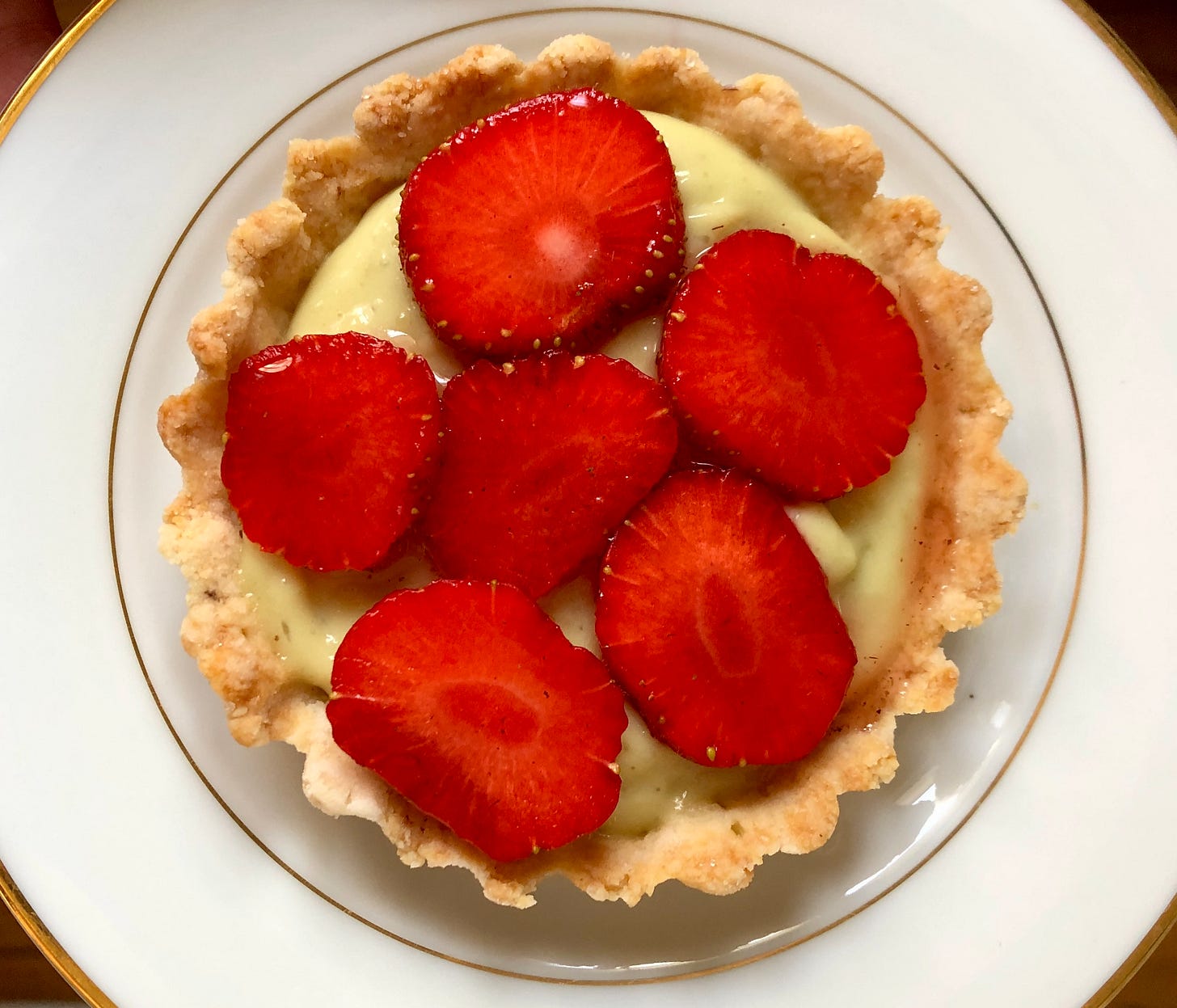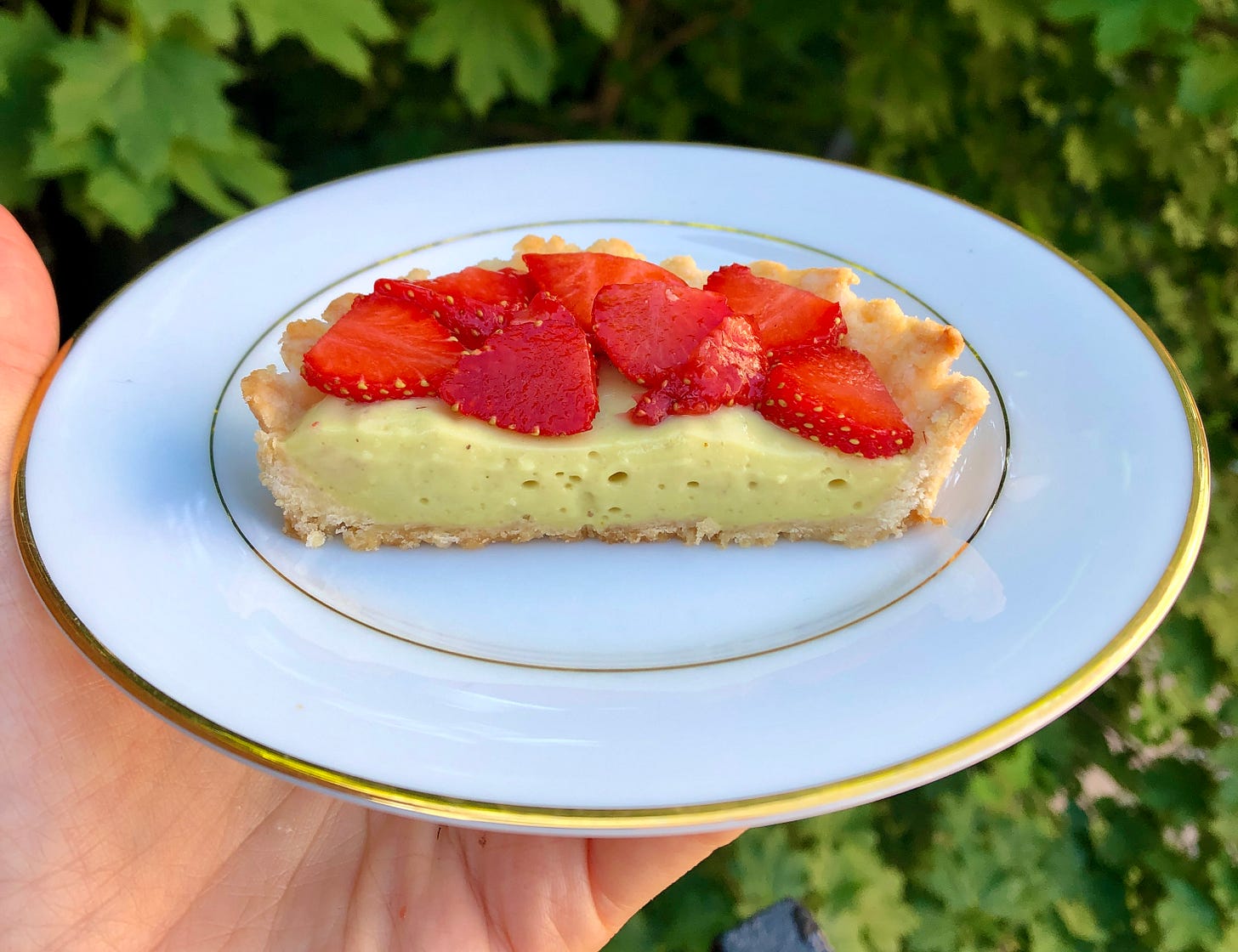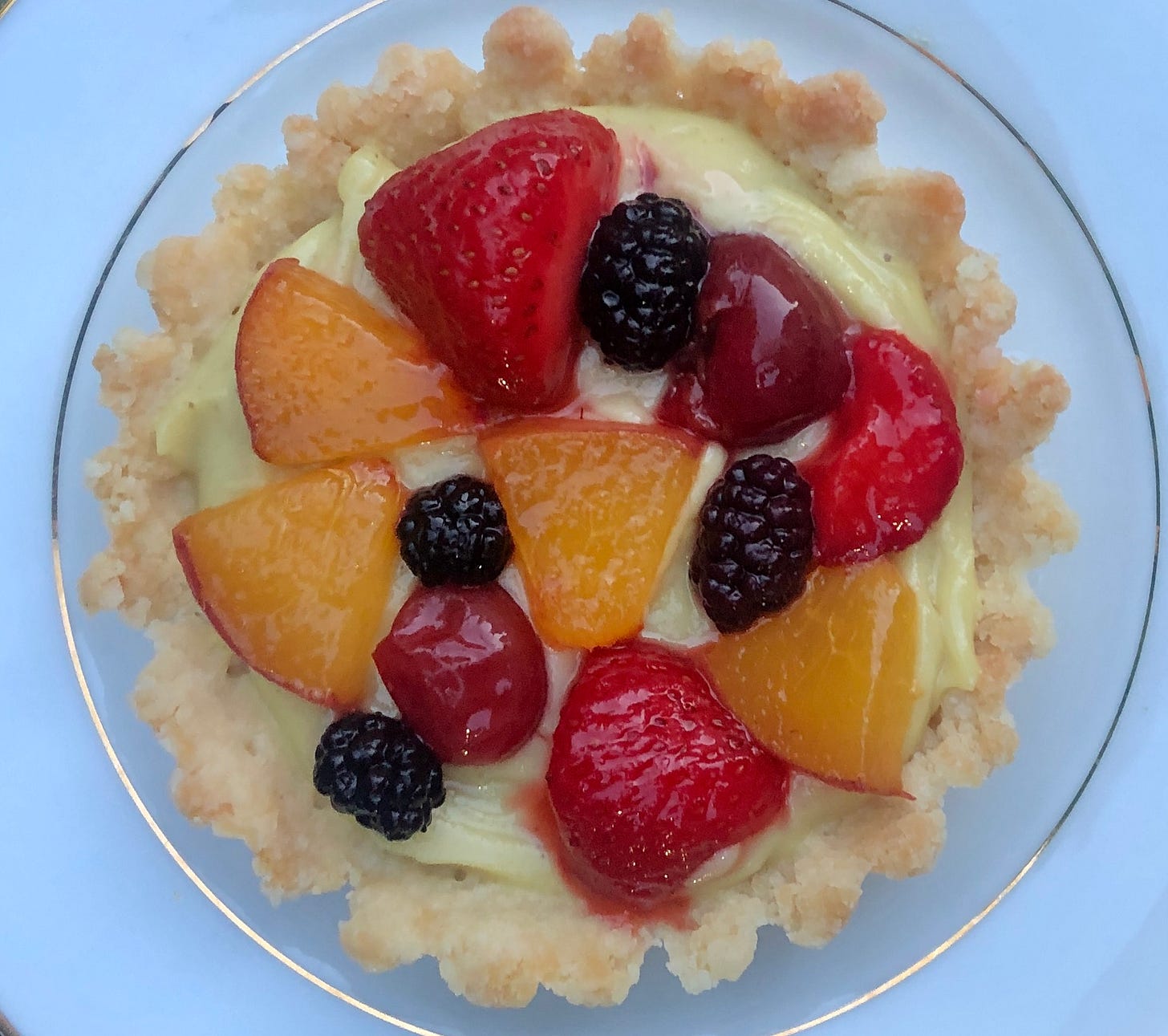I’m going out of town tomorrow, my apartment was/is a mess, it gets dark at 5pm, etc. so I took the week off my Great Canadian Baking Show But Vegan challenge to tend to all of that (check out last week’s vegan macarons in case you missed them). But as “The Holidays” thunder toward us, I thought I’d do what I hope is an act of service and finally put out my recipe I’ve been sitting on for vegan pastry cream. Maybe that’s something you could use?
It hasn’t been tasted and appraised by as many omnivores as I had hoped it would be before its release, but I think it’s really good! And I did make tarts with it in the early fall and brought them to my dairy-eating friend’s place to try, but we weirdly forgot to eat them so my friend brought them to a family function the next day. The tarts got thoroughly jostled on the subway so they arrived all broken and weird looking, and while my friend still didn’t try them herself, her notoriously fussy and annoying uncle did and emphatically declared that the tarts were great but couldn’t possibly be vegan because custard can’t be vegan. So! I’d say that’s a good enough endorsement? Let’s go!
The secret ingredient in this pastry cream is, of course, beans! How vegan is that? Haha. Specifically it’s fava bean flour, and you probably already knew that because I already wrote about it here, and wrote about how I learned of said flour’s custardy properties here, and in spite of all of that I have not yet seen pastry cream made with fava flour going viral, so. Please let this be the day that changes! Though there are perfectly fine vegan pastry creams made with just cornstarch, I truly believe that the fava flour adds a kind of body and je ne sais quois that is otherwise lacking, without adding any untoward taste. And if you’re someone who’s freaked out by beans in your desserts, allow me to remind you if you don’t already know that there’s beans in so many delicious desserts around the world! From the white bean tarts of Portugal to many popular mung bean desserts in China; India’s ladoos and burfi made from chickpea flour to anko, the popular sweet azuki bean filling from Japan. Beans! They’re for dessert!
I admit fava bean flour as of this writing can be hard to find at the grocery store, but it’s easy to order in Canada from Cuisine Soleil (also sold at lots of health food stores and Well.ca), and in the states I’ve seen it here. You can also just blitz dry split fava beans to a fine powder in a decent blender, food processor, or spice grinder. The Cuisine Soleil brand is stone-ground, so there are sometimes some slightly larger chunks. If I’m really going hard, I’ll sift it to ensure it’s extra smooth, but normally I don’t bother and everything’s fine. In terms of cost, right now twelve organic eggs and a 700 gram bag of fava bean flour cost the same amount of money where I live, and you get the equivalent of about 40 eggs out of that bag of flour judging from my highly guesstimated math, so I think it’s a decent deal.
If you have questions about this ingredient, or you’ve tried it and think it tastes either great or gross, please let me know. Sometimes I really do spend full minutes simultaneously enjoying a custard tart and shaking my head in confusion about why more people aren’t using this stuff!
Vegan Pastry Cream
Obviously this is pretty different because vegan, but I used Alison Roman’s recipe as my starting point. This makes about 1.5 cups of pastry cream, enough to fill four tartlet shells for example. I’m sorry to use only imperial volumetric measurements here. I was suddenly seized with the desire to get this out quickly and I have not weighed the ingredients yet. I will try to do so next time and update with grams.
Ingredients:
1 tbsp fava bean flour, sifted if you like → ½ tbsp per egg yolk as a general rule
3 tbsp coconut milk → 1.5 tbsp per egg yolk as a general rule
2 tbsp cornstarch
Small pinch turmeric for colour (I want to test annatto next, let me know if you do!)
Pinch of fine sea salt
1 cup soy milk (I reckon almond milk would also work, I fear oat could get gloopy, but I haven’t tested either)
¼ cup granulated sugar
1 tsp vanilla extract (if you’re a vanilla bean person, certainly use one instead!)
1 tbsp coconut oil (you can use a liquid oil like light olive or canola, the cream will just be a tiny bit looser, but still great!)
Method:
Whisk together the coconut milk, fava bean flour, cornstarch, vanilla extract, turmeric, and salt and let that hydrate for about 15 minutes.
Meanwhile, combine the milk and sugar in a medium pot. Bring to a simmer over medium heat. Once simmering, remove from the heat.
Pour a little of the hot milk mixture into the fava bean mixture and whisk vigorously to blend until smooth.
Add this mixture back into the pot and heat it all together over medium-low heat, stirring constantly. I usually alternate between a fork and a spoon at this point. The bean flour likes to clump at the bottom, so make sure you scrape the bottom with your spoon as you stir. I find a few lumps at this stage usually sort themselves out eventually, and you can always strain it at the end if you’re worried.
After five to seven minutes of stirring and heating, the mixture should thicken a lot and will start to boil in that thrilling pudding way where huge bubbles slowly rise to the surface.
I like to let it go another two minutes at that stage, then remove from heat, and whisk in the coconut oil.
I let it cool a little, stirring to mitigate skin formation, then put a piece of wax paper on top of the cream, put the lid on the pot, and refrigerate. Like regular pastry cream, this sets up fairly rubbery in the fridge. It just needs a good beating to get it creamy for use after chilling, which can be done with a fork or a hand mixer, depending on if you want any aeration. I have basically only used this for fruit tarts so far, but it’s nice and thick, I’m pretty sure you could pipe it into things without trouble when it’s cold.
Another thing you can do is pour the pastry cream into tart shells when warm, broil the tops briefly, and then chill for a sort of cheater’s pastel de nata. Below is a foil crust-protector I rigged up for the broiling process, but I think a torch would make the job a lot easier and more even. I do not recommend full-on baking this cream after it’s been cooked, it gets way too thick and weird. I am still working on my less cheater-y pastel de nata, so stay tuned for that, possibly for a long time, haha.
Let me know any questions you may have below or in the DM’s or whatever, happy to help your vegan pastry dreams come true!








Any thoughts about making a lemon curd with this? looks great!
I have the ingredients, I'm doing it this weekend! I'M SO EXCITED FOR VEGAN PASTRY CREAM! Sorry, I'm weirdly invested in making this as you may remember from when you first mentioned it! I'll let you know how it goes!